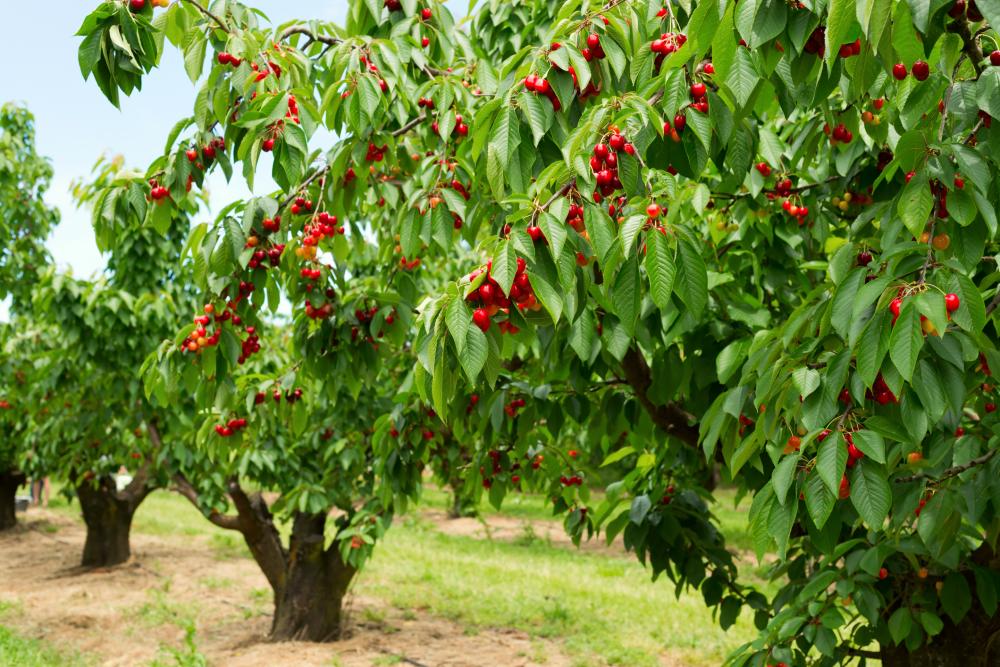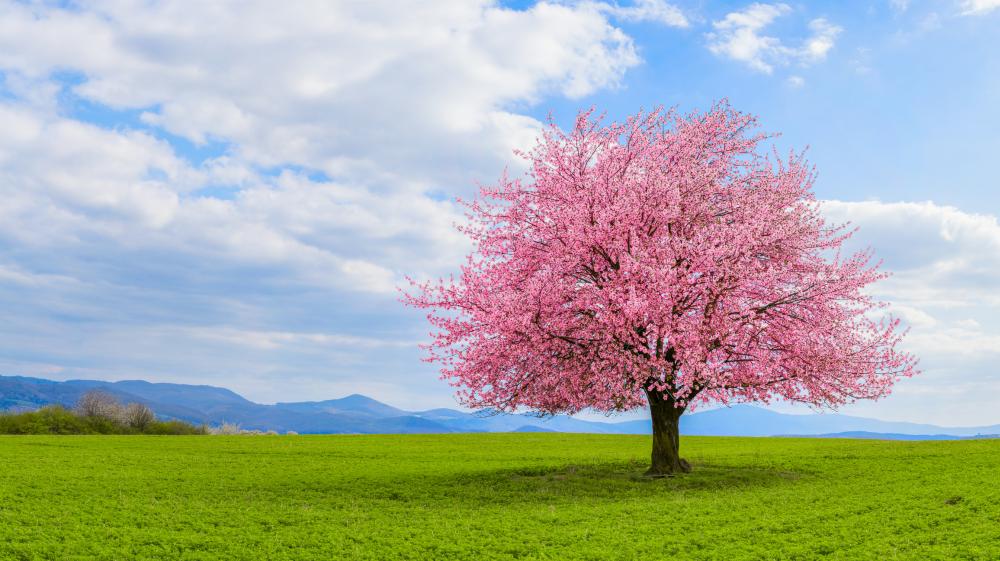Cherry Tree – How To Grow And Care For Cherries
The cherry tree is the right fruit tree for your garden whether you’re interested in its fruits or not. A lavish tree that fills the garden with lush green shades in the spring, its blossoms are as beautiful as they are fragrant. And by early summer, you’re ready to get a taste of the delicious cherries which take no time to grow and ripen.
So what does it take to grow a cherry tree in your garden? Not much really. All you need is enough space, a warm spring, and plenty of sunshine. Once the tree establishes, it’s ready to blossom and bear fruit. Read on to find out how to plant, care for, and harvest the cherry tree in your backyard.
All About Cherry Tree
As much as we’d all love to have a tree that sprouts quickly, grows to its full height, and starts producing fruits that same year, that doesn’t happen often if at all. At least that’s not the case with the cherry tree (Prunus avium). You’ll need to be patient with this one as it slowly grows and starts to bloom. It would take 4 years for the sweet cherry types to finally produce cherries.
Some varieties such as dwarf cherry trees will develop much faster although they too will need at least 3 years to fruit. And the hardiness zones vary depending on the cherry type as well. Sweet cherries can grow in zones 5 to 7 while the hardy sour cherries can grow in cooler zones between 4 to 6.
Another important difference between sweet and sour cherries is that while the first type is half-sterile and needs help getting pollinated. Sour cherry trees on the other hand are self-pollinating and have no use for pollinators or even other cherry trees nearby.
The blossoms of the cherry appear in mid-spring and can either be white or pink depending on the variety. Their fragrance is strong and attracts pollinators from miles away. Once pollinated you can expect to harvest between 60 to 100 pounds of cherries each year.
Cherry Tree Varieties
Besides the two main types, sweet and sour, cherry trees come in many varieties and cultivars. Some of these cultivars are cold-hardy or disease resistant while others have a better yield and more appetizing cherries. Here are some cherry varieties to consider in your garden.
- Black Tartarian: A spectacular variety that originally comes from Russia. It first arrived on American shores in the early 18th century. The tree turns into a ball of white as the white blossoms open in the mid-spring. The cherries on the other hand are dark red and almost black. This earned the tree the nickname Large Black Heart because of the shape of the fruits.
- Tibetian: This variety is beautiful in every way. It has copper branches and extra sweet cherries. Native to Tibet, the tree has a small and compact structure and its canopy develops into a perfect dome over its short trunk. You can grow it for its ornamental values or for its delicious fruits.
- Van: The Van cherry tree is grown mainly for its sweet and juicy cherries more than its ornamental values. When fully grown, the branches of the tree grow in every direction and give it a wild look. However, each branch will carry more than double its weight in delicious cherries so it got that going for it.
- Lapins: This cultivar is a crossbreed between Stella and Van varieties. Originally developed in Canada, it has a high tolerance for cold weather. The fruits of this cultivar are dark red with firm flesh. Each cherry is about one inch in diameter. It grows in zones 5 to 9 and needs about 900 chill hours.
- Yoshino: An elegant tree that comes from Japan. The branches and trunk are upright and when the blossoms cover the canopy, the tree looks like a huge ball of pink. The leaves of the tree emerge after the flowers and will drop by the end of the summer.
How to Grow Cherry Tree
The best times to start your cherry tree are either in the spring or fall. And depending on the space you have for the tree, you might have to choose that fits within that space. A Kwanzan cherry is tall and grows upright while a Yoshino tree spreads its branches wide. Here’s how to do that in easy steps.
- Choose a spot that gets either full sun or partial shade depending on the cultivar you’re growing.
- Till the land and turn up the top 12 inches of soil. Mix in plenty of organic material and amend the soil to loosen the texture and improve drainage.
- Let the soil rest under the sun for a few days to solarize it.
- Dig a hole in the middle of the tilled spot that is as deep as the distance from the bottom of the root ball to the soil mark on the trunk. Make it a few inches wider than the diameter of the root ball.
- Make sure the nearest tree is at least 30 feet away to improve air circulation.
- Unwrap the tarp around the root ball or ease the sapling out of the pot it came in and examine the roots. Trim off any damaged or entangled roots.
- Ruffle the roots with your hand so they fill up the bottom of the hole and backfill with soil. Firm the soil to chase out pocket holes and keep the sapling standing upright.
- Place a stake next to the tree and tie the sapling to the stake to protect it against strong winds.
- Water the tree to get the soil thoroughly moist.
- Cover the area around the tree’s drop line with shredded bark and fallen leaves to prevent weeds from growing and improve the water retention of the soil.
Cherry Tree Care
Most fruit trees become relatively independent once they establish in the garden. And the cherry tree is no different. It will take between 3 to 4 years to reach full maturity and start flowering. Those are the years when the tree will need your attention the most. From watering to feeding and pruning. After that, pruning would be the main concern since the tree has a tendency to grow branches everywhere without following a pattern.
Soil
Although trees can survive in most soil types, fruit trees are a little too particular about their soil demands. Both heavy and sandy soil is out of the question. The first retains water for too long causing the roots to rot and the second doesn’t hold water long enough for the roots to absorb the moisture. Your best bet is to amend the soil and make it as close to loamy as possible. Loamy soil has silt as well as sand to create a balanced texture. Aim for soil pH that is between 6.3 to 7.2 for sweet cherries and 6 to 7 for the sour types. If the acidity in the soil is already too high, avoid using mulch with lots of organic materials that would break down and release more acids into the soil.
Water
If you’re one of the lucky ones who live in a rainy microclimate, then you won’t have to worry about watering your cherry tree. As long as you get one inch of rain per week, the tree won’t need any more watering from you. But if you don’t get enough rainfall during the spring and summer, then you’ll need to make up the deficit. Wate the tree deeply when the top 2 inches of the soil are dry. This can amount to up to 2 irrigations per week. If the weather is too hot and the soil dries out fast, you can increase that to three times a week. Build a ridge around the trunk of the tree to hold the water. That way you won’t waste any of the water quotas.
Fertilizer
Whether you want to grow an organic cherry tree or not, the tree needs to be fed. The type of fertilizer you use is up to you although I recommend using aged manure, organic compost, and homemade fertilizers. Chemical fertilizers besides affecting the taste of the cherries stress the tree with the sudden growth spurts they trigger. On average the tree will need about two applications of fertilizer per year. Apply the slow-release fertilizer in the early spring around the time the flower buds emerge. The second application would be when the cherries start to develop. If you want to use commercial fertilizers, apply them at half the recommended dose and water the tree immediately after. Low-nitrogen fertilizers are ideal for the cherry tree since the blooms are first to emerge and long before the leaves.
Pruning
Your pruning tasks will vary widely and depend on the variety or cultivar of cherry tree you have growing in your garden. But on average you’ll need to do a few touch-ups on the overall shape and stature of the tree about twice a year. The first is in the early spring before the flower buds have appeared. Remove damaged and sick branches with sterilized shears. If two branches are entwined, choose the stronger of them to stay and cut the other one. Also, make inroads and paths inside the canopy for airflow and sunlight. Each branch will carry a heavy load of cherries, so it needs its fair share of the sun even if it’s deep inside the tree. The late summer pruning is for cleaning up the tree and thinning out the branches in preparation for the coming winter.
Pests, Birds, and Diseases
Although pests such as thrips, Japanese beetles, cherry fruit fly, leafhoppers, and borers can cause a lot of damage to the tree and the cherries, it’s birds that you should focus your attention on. Most insect infections can be treated with neem oil. In the case of Japanese beetles, just manually pick them one by one and drown them in a bucket full of water with some dish soap mixed in.
But it’s the birds that can decimate the cherry harvest every year because of their sheer numbers and their voracious appetite. And birds are not only satisfied with eating a whole cherry. They also peck at each fruit in sight causing the cherries to rot. To avoid this annual devastation, wrap the cherry tree in netting and use a fake hawk to scare off the birds. You can also bribe the birds with easier food such as wildflowers, especially echinacea and rudbeckia.
Harvesting Cherry Tree
Some cherry tree varieties ripen early in May and you can start harvesting as soon as the cherries become dark red. Squeeze a ripe cherry gently between your thumb and forefinger to determine if it’s ready to pick. It should be tender and gives in slightly under pressure. Pick a ripe cherry and eat it. If it’s sweet, then start harvesting right away and before birds ravage the whole crop.
To store the cherries, keep them in the fridge for up to a week. You can also freeze them where they’ll stay fresh for months on end.


